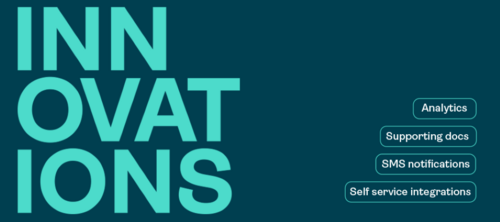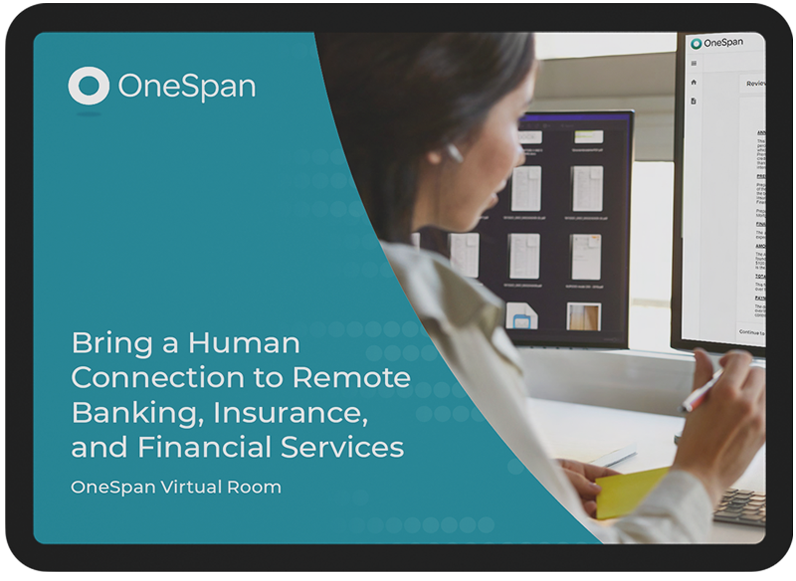Top 5 Requirements for a Secure Virtual Signing Experience

Do consumers want to go back to all in-person experiences to sign contracts and agreements? We’ve moved to a more remote world with videoconferencing software becoming an integral part of our lives to connect with work colleagues and conduct business with companies from the comfort of our homes. With consumers expecting more convenient, personalized digital experiences in today’s anywhere economy, closing deals and signing routine agreements in a face-to-face meeting may be a thing of the past.
Consumers across all age groups have become more comfortable with digital tools and there is a growing desire to interact with companies via videoconferencing solutions to facilitate face-to-face interactions. According to Accenture, before 2020, 15% of consumers had used a video call to communicate with an advisor. Now, 46% said they would be willing to do so, and more importantly, 35% now prefer a video solution to a face-to-face meeting.
This presents a unique opportunity for organizations to create personalized, high-touch, human-assisted experiences with consumers who prefer virtual interactions. Enterprises could patch together their preferred videoconferencing tool with other collaboration technologies like eSign and co-browsing, but there is a better way.
Video-based e-signature solutions recreate the in-person signing experience by combining the value of human and digital assistance. But not all video-based e-signature solutions are made equal. Here are the top 5 electronic signature requirements to consider when selecting the best solution for mediated use cases or in workflow scenarios where you need to work directly with the customer to get agreements signed in electronic form.
Is the Video-based eSigning Solution Secure?
With the long-standing Uniform Electronic Transactions Act (UETA) and Electronic Signatures in Global and National Commerce Act (ESIGN Act) governing the use of electronic signatures in US federal law, eIDAS in the European Union, and similar e-signature laws around the world, the legal requirements are not in dispute. But, is the solution secure?
Facilitating live, virtual signing sessions is a convenient way for organizations to engage and build loyalty with customers. It eliminates the hassle of customers travelling for in-person meetings to sign documents with handwritten signatures, as well as the back and forth to get agreements signed over phone or email. While convenience is important, the security of the solution is critical to ensure organizations and their customers are protected during the virtual signing session. When evaluating video-based e-signature solutions, it’s important to understand that not all video-based e-signature solutions provide the necessary level of security to prevent tampering and may put your customers and organization at risk. Ask the vendor:
- Does the solution offer a wide range of identity verification and authentication options to ensure you’re interacting with the right individual before they gain access to the agreements? Most videoconferencing solutions in the market fall short with the authentication methods and functionality available for verifying the signer’s identity. For example, ID verification is often not offered, which may be a requirement to validate unknown individuals an organization does not already have an established relationship with. Or passwords to access signing sessions from traditional screen sharing software are not enforced, leading to unwanted guests entering the signing session. In one video-based e-signature solution, when Knowledge-based Authentication (KBA) is used, all parties in the session can see a participant’s answers to access the signing session, exposing private personal information to all participants in the session. It’s important to assess safeguards included in a video-based e-signature solution to ensure you’re engaging with customers remotely in a secure manner.
- Does the solution have built-in security controls to block participants from signing on behalf of others? Some video-based e-signature solutions lack the built-in security controls required to conduct a secure virtual signing session with customers. Recent news reinforces the importance of having security controls in place to prevent participants signing on behalf of others. Look for solution providers that offer the necessary built-in security controls with co-browsing capabilities that block participants from signing on behalf of others. Opting for a less secure video-based e-signature solution can jeopardize your brand, leading to loyal customers losing trust and switching to your competitor’s brand and even potential lawsuits related to your electronic records.
Does the Solution Give the Host a High Level of Control?
Virtual signing sessions allow participants to easily review and sign agreements in real-time. The host (agent or advisor, for example) can provide live assistance by guiding customers through agreements in much the same way as they would with paper documents. As they do so, the host will need to pass signing controls to the customer or signatory. Be aware that not all video-based e-signature solutions offer the appropriate level of control and may put all parties in the virtual signing session at risk. Ask the vendor:
- Can the solution restrict the content that can be shared in the virtual signing session? Co-browsing provides a high-level of control for the host and signers in the virtual signing session, because it restricts the content that can be viewed and shared in the session. In other words, the host can only share the agreement that needs to be signed – instead of their entire screen. In terms of risk exposure, this goes beyond just making sure that on-screen notifications from the host’s other apps (e.g., private Slack messages) are not visible to the customer. Verify that signers do not have access to anything other than the documents that require their signature. Otherwise, if signers can access the host’s browser tabs, other documents on the desktop or internal applications, this introduces risk. Security controls that restrict content provide peace of mind for you and your agents by ensuring a secure signing session for all parties in the session.
Is the Video-based eSign Solution Compliant?
Beyond electronic signature laws, state laws, or other legal frameworks, regulated industries undergo compliance audits and rely on electronic evidence to demonstrate how employees and customers completed the signing process. This information is captured in an audit trail and demonstrates who signed what agreement, the signing order, timestamps of when the agreement was signed, and the IP address of where the agreement was signed.
If ever a legal dispute arises over an electronically signed agreement, judgment will be rendered based on the strength of the electronic evidence admitted. The electronic evidence must be accurate and reliably reproduced to maintain its integrity in a court of law. Most video-based e-signature solutions in the market fall short when proving compliance, because signing events are not accurately captured in their audit trail – raising concerns and putting the integrity of the signed agreements and electronic evidence into question. The integrity of signed documents and audit trails is key to admissibility and enforceability. Ask the vendor:
- Are signing events in the virtual signing session accurately captured in the audit trail? Does the audit trail include signing events such as:
- Signing privileges being passed between the host and participants
- The signing order that took place in the virtual signing session
- IP addresses and geolocation details of all participants captured in the signing session
- Accurate information and attribution of the channel used for participants to sign agreements
How Easy is it For the Host to Launch a Video-based Signing Session?
Adding a video-based e-signature solution to your digital toolkit will help your organization engage with employees and customers and onboard them faster. Time is of the essence, so you want to make sure you are focused on value-added activities like building relationships with customers, instead of spending time toggling between apps to schedule and launch a virtual signing session. The solution you choose should be quick and intuitive to send an agreement and schedule the virtual signing session in just a few clicks. Some video-based e-signature solutions in the market offer a fragmented user experience, slowing turnaround time to complete agreements. Ask the vendor:
- Is the solution fully integrated? Can your employees prepare agreements and schedule the signing session within a single app? Or do they need to toggle between apps and emails? Select a video-based e-signature solution to streamline the experience, so the host can connect and get agreements signed by customers quicker.
Customer Experience: One of Your Top Electronic Signature Requirements
Video-based e-signature solutions elevate the customer experience with an innovative way of blending the value of human and digital assistance to complete mediated agreements remotely. Virtual signing sessions are collaborative and allow users to build loyalty with customers through a connected experience. To increase customer adoption, the solution needs to provide a seamless, end-to-end paperless experience to drive agreement completion rates.
Ask the vendor:
- Can the participants easily identify who is completing the agreement in the virtual signing session? Some solutions provide annotation tools to help users guide customers through the agreement. While annotation tools are useful, participants may be confused about the order of signers completing the agreement on-screen or who currently holds signing privileges in the session. Co-browsing enables users to provide visual guidance to signers by clearly indicating the signer order and which signer is completing the agreement in real-time. The signer’s cursor clearly identifies their name so everyone can keep tabs on specific events occurring during the signing session.
- Do you offer white-labeling capabilities? Some solutions offer custom-branding options like adding your logo or customizing brand colors to a webpage. White-labeling on the other hand gives you the power to fully customize the signing experience end-to-end – from the email domain of the email invites sent to your signers, the content of the email notifications, to the virtual signing ceremony itself. Be aware that vendors who do not offer white-labeling are prime targets for email phishing attacks; these can put your organization and signers at risk with potential malware downloads and hackers exploiting customers’ identity and personal information.
- Is the experience responsive so customers can complete agreements quickly? Slow response time of the video-based e-signature solution can disrupt the virtual signing session with customers. This will slow time-to-completion and can even introduce frustration, where signers abandon the signing process altogether. Be sure to select a solution that is reliable and responsive to expedite the signing process.
The OneSpan Virtual Room Advantage
Virtual Room re-creates the power of the face-to-face meeting to complete agreements that require human assistance. It brings together electronic signature, web-enabled videoconferencing, and rich collaboration capabilities in one solution. OneSpan Sign Virtual Room offers:
- A secure solution that includes a wide range of identity verification and authentication options to choose from. Our solution enables you to verify the identity of both known customers, as well as unknown individuals that your organization does not have an established relationship with. Our solution also includes built-in security controls blocking participants from accidentally signing on behalf of others in the virtual signing session. Finally, we provide bank-grade security and digital signature encryption to ensure data and agreements signed in the Virtual Room are always secure.
- High level of control that ensures all parties involved in the signing session are restricted to only viewing the agreement that requires a signature. In addition to blocking participants from signing on behalf of each other, co-browsing restricts access from participants accessing other participants’ desktop, browser tabs, sensitive documents, or internal applications.
- A compliant solution that proves intent and ensures document integrity with accurate, comprehensive electronic evidence captured in the audit trail. Unlike other solutions, our audit trail captures detailed events like signing privileges passed between host and participants, correct signing order, time spent reviewing the agreement, IP addresses and geolocation details indicating where the agreement was signed, and more. In addition, Virtual Room includes the capability to record the signing session to reinforce the electronic evidence captured in the audit trail.
- A solution that’s easy to use. Virtual Room is an all-in-one solution that includes e-signature, videoconferencing, and rich collaboration features – eliminating the hassle of preparing agreements, sending invites and initiating a virtual signing session from multiple apps.
- A superior customer experience with a seamless, fully white-labeled experience to expedite agreement time to completion and drive higher completion rates with signed documents.
With Virtual Room, your customers get the help they need from the convenience of their home or office. And your organization gets access to a new, high-touch channel to engage with employees and customers in the signature process as humanly as possible.









